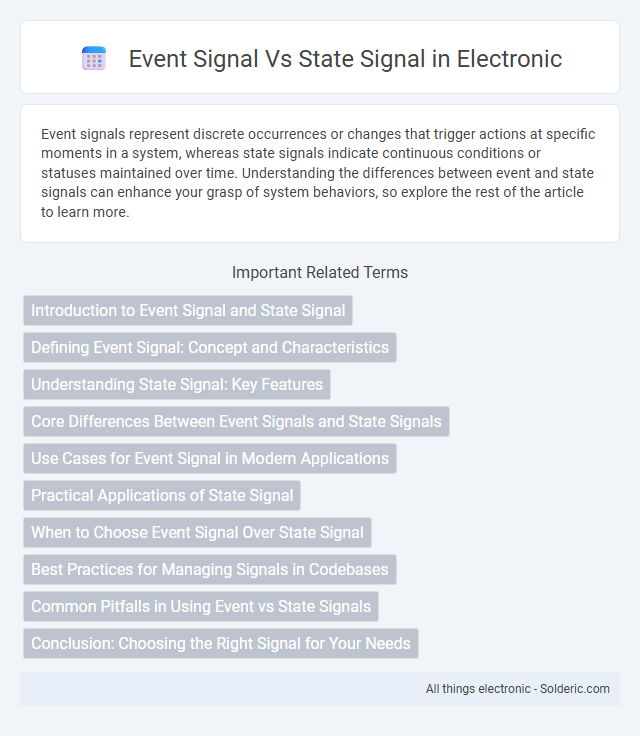Event signals represent discrete occurrences or changes that trigger actions at specific moments in a system, whereas state signals indicate continuous conditions or statuses maintained over time. Understanding the differences between event and state signals can enhance your grasp of system behaviors, so explore the rest of the article to learn more.
Comparison Table
| Aspect | Event Signal | State Signal |
|---|---|---|
| Definition | Indicates an occurrence or change at a specific point in time | Represents the continuous condition or status of a system |
| Nature | Discrete, transient | Continuous, persistent |
| Data Representation | Timestamped occurrences or triggers | Current values or levels over time |
| Use Case | Notifications, alarms, user actions | System monitoring, status tracking |
| Signal Change | Occurs at a specific instant | Represents ongoing condition |
| Examples | Button pressed, sensor triggered | Temperature reading, system mode |
| Processing Focus | Event detection and handling | State maintenance and analysis |
| Storage | Logs of discrete events | Time-series of state values |
Introduction to Event Signal and State Signal
Event signals represent discrete occurrences or changes at specific points in time, commonly used in digital systems to trigger actions or transitions. State signals indicate continuous conditions or statuses that persist over a period, reflecting the system's current mode or configuration. Understanding the distinction between event and state signals helps you design more efficient control and communication protocols in electronics and software systems.
Defining Event Signal: Concept and Characteristics
Event signals represent discrete occurrences or changes within a system, characterized by their instantaneous nature and the absence of duration. These signals typically capture specific transitions or triggers, such as button presses or system interrupts, making them crucial for event-driven processes. Unlike state signals, event signals do not convey continuous state information but serve as precise indicators of changes that initiate actions.
Understanding State Signal: Key Features
A state signal represents continuous values that change gradually over time, reflecting the system's current condition or status. These signals hold sustained information, allowing real-time monitoring and control in dynamic environments like temperature regulation or voltage levels. Their stability and predictability enable efficient system analysis, fault detection, and process optimization.
Core Differences Between Event Signals and State Signals
Event signals represent instantaneous changes or triggers occurring at specific points in time, capturing moments when particular actions or conditions arise. State signals indicate continuous conditions or statuses maintained over a period, reflecting the current value or mode of a system. The core difference lies in event signals being discrete and time-specific, while state signals are continuous and persist until a change occurs.
Use Cases for Event Signal in Modern Applications
Event signals are crucial in modern applications for handling asynchronous actions such as user interactions, system notifications, and real-time updates. These signals enable your application to respond instantly to changes like button clicks, sensor triggers, or incoming messages, improving responsiveness and user experience. Event-driven architectures rely on event signals to manage workflows, automate processes, and integrate with external services efficiently.
Practical Applications of State Signal
State signals represent continuous values reflecting ongoing conditions, making them ideal for monitoring system statuses and controlling processes in real-time. You can apply state signals extensively in automation systems, where sensor readings track temperature, pressure, or speed to ensure smooth operation and immediate response. Their practical use includes maintaining safety thresholds and optimizing performance in industrial control applications.
When to Choose Event Signal Over State Signal
Choose an event signal over a state signal when indicating discrete occurrences or changes that do not persist over time, such as a button press or a sensor trigger, ensuring precise timing and minimal data overhead. Event signals are ideal for scenarios requiring immediate response to transient inputs, avoiding ambiguity caused by continuous state monitoring. Use event signals to detect and react to individual incidents rather than ongoing conditions, optimizing performance in systems where changes need to be captured as distinct, time-stamped events.
Best Practices for Managing Signals in Codebases
Managing event signals in codebases requires clear differentiation from state signals to ensure efficient event handling and state management. Best practices include using event signals to capture discrete occurrences like user actions or system events, while state signals should represent persistent data reflecting the current application status. Implementing reactive programming frameworks such as RxJS or Redux can enhance signal management by providing structured patterns for event dispatching and state updates, improving code maintainability and scalability.
Common Pitfalls in Using Event vs State Signals
Common pitfalls in using event vs state signals involve misinterpreting event signals as continuous states, leading to inaccurate system behaviors and missed triggers. Event signals represent discrete occurrences, so using them to represent ongoing conditions can cause logic errors in your system design. Confusing state signals with event signals often results in improper timing and synchronization issues in event-driven architectures.
Conclusion: Choosing the Right Signal for Your Needs
Event signals capture discrete occurrences that trigger immediate actions, ideal for scenarios requiring precise timing and responsiveness. State signals represent continuous conditions or statuses, providing a reliable overview of system behavior over time. Your choice depends on whether you need to monitor changes instantaneously or track ongoing states for analysis and control.
event signal vs state signal Infographic

 solderic.com
solderic.com